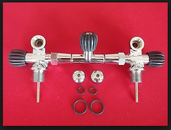SomeGuy509
Registered
Hi All,
When I picked up a bunch of gear over the summer one item I got was a 300 bar OMS manifold like the one pictured below. I was after some HP120s and this was thrown in as part of the deal. I noticed that it uses a single o-ring and setup as a face seal for the isolator between the two posts. Newer manifolds seem to use 2 o-rings per side that seal circumferentially.
I seem to recall reading something about certain manifolds being less safe due to the possibility of leaking if they are bumped. The single o-ring face seal seams a bit less secure then the double concentric but I'd like to try and confirm one way or another.
I'd like to try and do Into to Tech in the next year or two and I am wondering if I need to factor in the cost of one of the newer XS Scuba manifolds since I only have 7/8in neck tanks. The other thought may be that just for ITT and "lighter" tech diving the risk is low enough for the design to not matter.
Thanks!
When I picked up a bunch of gear over the summer one item I got was a 300 bar OMS manifold like the one pictured below. I was after some HP120s and this was thrown in as part of the deal. I noticed that it uses a single o-ring and setup as a face seal for the isolator between the two posts. Newer manifolds seem to use 2 o-rings per side that seal circumferentially.
I seem to recall reading something about certain manifolds being less safe due to the possibility of leaking if they are bumped. The single o-ring face seal seams a bit less secure then the double concentric but I'd like to try and confirm one way or another.
I'd like to try and do Into to Tech in the next year or two and I am wondering if I need to factor in the cost of one of the newer XS Scuba manifolds since I only have 7/8in neck tanks. The other thought may be that just for ITT and "lighter" tech diving the risk is low enough for the design to not matter.
Thanks!





